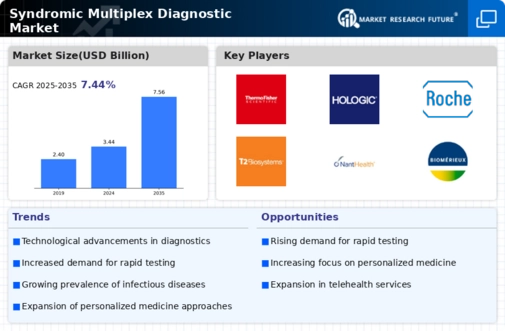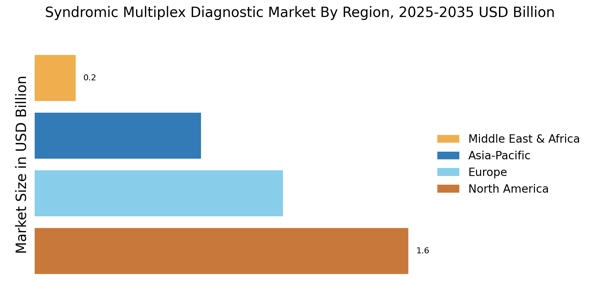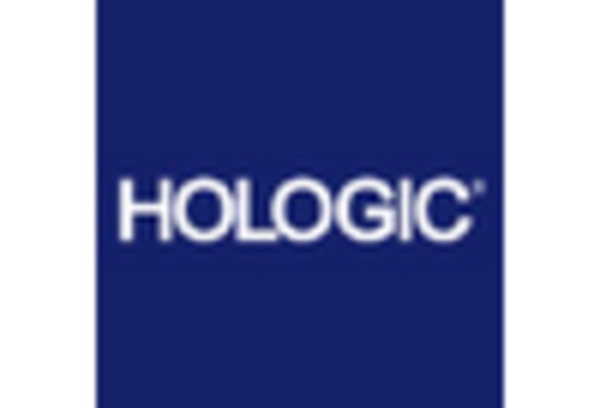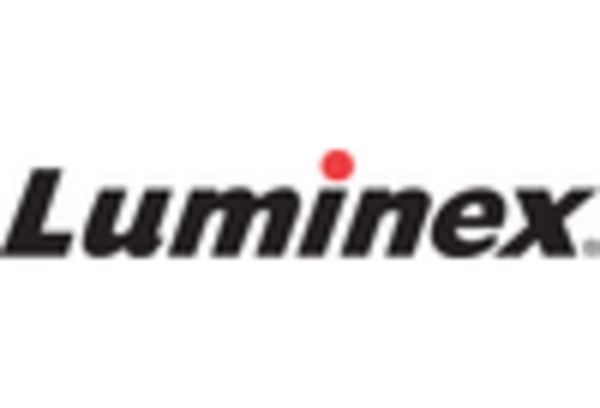Focus on Personalized Medicine
The Syndromic Multiplex Diagnostic Market is also being shaped by a growing focus on personalized medicine. As healthcare shifts towards more individualized treatment approaches, the demand for diagnostics that can provide tailored insights into patient health is increasing. Syndromic multiplex diagnostics play a crucial role in this paradigm by enabling healthcare providers to identify specific pathogens and their resistance patterns, thus facilitating targeted therapies. This trend is expected to drive market growth, with estimates indicating a potential increase in market size by 15% over the next few years. The ability to customize treatment plans based on diagnostic results not only enhances patient outcomes but also optimizes resource utilization within healthcare systems. Therefore, the emphasis on personalized medicine is likely to be a key driver in the evolution of the Syndromic Multiplex Diagnostic Market.
Rising Prevalence of Infectious Diseases
The Syndromic Multiplex Diagnostic Market is significantly influenced by the rising prevalence of infectious diseases worldwide. As the incidence of conditions such as respiratory infections, gastrointestinal diseases, and sexually transmitted infections continues to rise, the need for effective diagnostic solutions becomes increasingly critical. Syndromic multiplex diagnostics offer a comprehensive approach by enabling the simultaneous detection of multiple pathogens, which is essential for accurate diagnosis and treatment. Market data indicates that the infectious disease diagnostics segment is expected to account for a substantial share of the overall market, with projections suggesting a growth rate of approximately 9% over the next few years. This trend underscores the importance of syndromic multiplex diagnostics in addressing public health challenges and improving patient care within the Syndromic Multiplex Diagnostic Market.
Technological Advancements in Diagnostics
The Syndromic Multiplex Diagnostic Market is experiencing a surge in technological advancements that enhance diagnostic capabilities. Innovations such as next-generation sequencing and microfluidics are revolutionizing the way syndromic multiplex tests are conducted. These technologies allow for the simultaneous detection of multiple pathogens, significantly reducing the time required for diagnosis. As a result, healthcare providers can make more informed decisions, leading to improved patient outcomes. The market is projected to grow at a compound annual growth rate of approximately 10% over the next few years, driven by these advancements. Furthermore, the integration of artificial intelligence in diagnostic tools is expected to streamline workflows and enhance accuracy, thereby further propelling the Syndromic Multiplex Diagnostic Market.
Regulatory Support and Funding Initiatives
The Syndromic Multiplex Diagnostic Market is benefiting from increased regulatory support and funding initiatives aimed at enhancing diagnostic capabilities. Governments and health organizations are recognizing the importance of rapid and accurate diagnostics in managing public health crises. As a result, there has been a notable increase in funding for research and development in the field of multiplex diagnostics. Regulatory bodies are also streamlining approval processes for innovative diagnostic tests, which is likely to encourage market entry for new players. This supportive environment is expected to foster innovation and drive market growth, with projections indicating a potential increase in market value by 11% over the next few years. The combination of regulatory support and financial backing is crucial for advancing the Syndromic Multiplex Diagnostic Market and ensuring the availability of cutting-edge diagnostic solutions.
Increased Demand for Rapid Testing Solutions
The Syndromic Multiplex Diagnostic Market is witnessing an increased demand for rapid testing solutions, particularly in emergency and outpatient settings. Healthcare facilities are increasingly prioritizing tests that provide quick results, enabling timely treatment decisions. This trend is particularly evident in infectious disease diagnostics, where rapid multiplex tests can identify multiple pathogens within a single assay. The market for rapid testing is anticipated to expand significantly, with estimates suggesting a growth rate of around 12% annually. This demand is fueled by the need for efficient patient management and the rising prevalence of infectious diseases. Consequently, manufacturers are focusing on developing user-friendly, rapid diagnostic kits that cater to this growing need, thereby enhancing the overall landscape of the Syndromic Multiplex Diagnostic Market.


















Leave a Comment